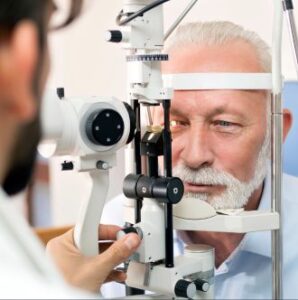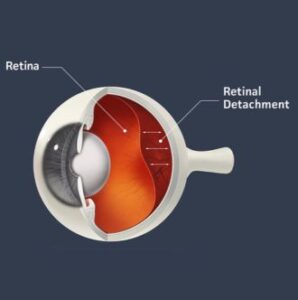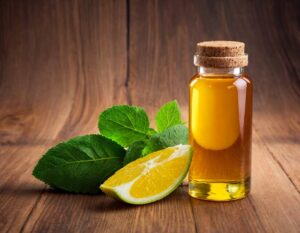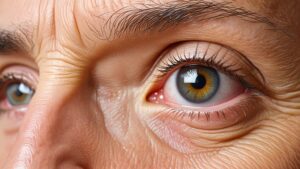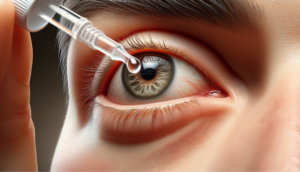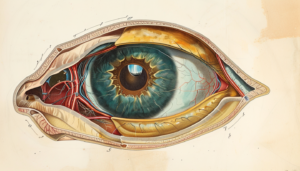The best ingredients in nutritional supplements can help to improve the quality and quantity of tears and alleviate some of the symptoms of dry eye disease.
Dry eye disease affects hundreds of millions of people around the world. It is often referred to as a multifactorial disease, meaning that it includes a spectrum of different clinical findings and symptoms, resulting from complex processes involving the surface of the eye (ocular surface). The term “ocular surface” includes the tear film, lacrimal glands, meibomian glands, cornea, conjunctiva, and eyelids.
The symptoms can range from being mildly irritating and inconvenient to quite severe, causing extreme pain and discomfort, restriction of daily activities and decreased general health. [5]

Dry eye disease is a multifactorial disease that affects hundreds of millions of people around the world.
Two Types of Dry Eye Disease
There are most commonly two types of dry eye disease, aqueous deficient dry eye (eyes do not produce enough tears) and evaporative dry eye (poor quality tears that evaporate from the eye surface too quickly). Determining which one someone has can identify the best treatment to use.
The goal of treatment is to return the surface of the eye to a normal, balanced state, and eliminate ongoing inflammation and discomfort. This can be achieved in three ways;
1. increasing the amount of tears or liquid on the eye surface
2. reducing tear evaporation, and
3. improving the quality of tears (often by increasing lipid content or lubrication).
Although short-term treatments may provide relief of symptoms, it is important to consider any long-term effects that chronic dry eye may have had on overall eye health.
Can Nutritional Supplements Help with Dry Eye Disease?
Yes, some key ingredients in nutritional supplements can help to improve the quality and quantity of tears and alleviate some of the symptoms of dry eye disease, it is like helping dry eye symptoms from the inside out, naturally.
What are the best supplement ingredients that can provide natural tear support for dry eye disease?
1. OMEGA-3 FATTY ACIDS
Omega-3 fatty acids are polyunsaturated fatty acids (PUFAs) that are commonly found in nature and play an important role in diet and health. Given that oral intake of omega-3 fatty acids is generally inadequate, many eyecare professionals have noted clinical improvement in their patients with dry eye disease that have started taking omega-3 fatty acid supplements. A 2019 meta-analysis of 17 randomized clinical trials (3363 people with dry eye disease) reported that supplementation with Omega-3 fatty acid significantly improves dry eye signs and symptoms. The researchers concluded that these findings indicate that Omega-3 fatty acid supplementation may be an effective treatment for dry eye disease. [2]
Omega-3 fatty acids also play a key role in the body’s ability to regulate and balance inflammation.
Omega-3 fatty acids appear to improve the lipid layer on the surface of the eye, which helps the eye stay lubricated and tears evaporate more slowly.
When taken as directed on the package instructions, most Omega-3 supplements have few side effects and are generally safe. As always, please check with your primary care physician prior to starting any dietary supplement. High doses of omega-3 can be harmful and may lead to increased bleeding risk, increased low-density lipoprotein (LDL) cholesterol, and blood sugar control problems.
DO ALL OMEGA-3 SUPPLEMENTS CONTAIN FISH OIL?

Supplements containing Omega-3 algal oil, sustainably sourced from algae, is a vegan source of essential fatty acids in one of the purest forms.
Many omega-3 fatty acid supplements are made from fish oil, but there are excellent sources of omega-3 fatty acids that are vegan and do not contain fish oil, or its fishy odor. Supplements containing Omega-3 algal oil are sustainably sourced from algae. Omega-3 from algae helps eliminate concerns related to environmental pollutants such as mercury, dioxins and industrial chemicals such as polychlorinated biphenyls (PCBs) that have been associated with consumption of fish and fish oil products. Algae is the original source of omega-3 fatty acids consumed by fish, but free of potential chemical and other contaminants that accumulate in fish over their lifetime.
2. MAQUI BERRY EXTRACT

A maqui berry is a small dark purple berry grown in Chile and may also be known as a Chilean Wineberry, or by its scientific name Aristotelia chilensis. Maqui berry extract, often available in combination with other ingredients like omega-3s fatty acids, has been shown to demonstrate powerful antioxidant and anti-inflammatory activity.
Maqui berries demonstrate powerful antioxidant and anti-inflammatory activity, which protects against moisture loss and supports increased tear production.
These antioxidant and anti-inflammatory qualities translate into being protective against moisture loss in dry eye and they also support an increase in healthy tear production. The compounds that give the maqui berry its deep purple color are anthocyanins, a type of antioxidant that has been shown to have a protective effect on the delicate lipid layer of eye membranes, helping to prevent evaporation and retain moisture on the surface of the cornea. The antioxidants also protect the lacrimal glands, where tears are made, from damaging oxidative stress, which could lead to reduced tear production over time.
A clinical study was conducted, specifically designed to assess the amount of tears people produced after taking maqui berry extract supplements for one month. Participants significantly increased tear fluid secretion after the first month, and after an additional 30 days, the amount of tears remained high. [3]
3. VITAMIN E
Vitamin E is a powerful antioxidant that is important to maintaining healthy eyes. Vitamin E works in our bodies to help form red blood cells, improve immune function and specifically in our eyes, it can help to deactivate harmful free radicals, which are atoms of oxygen that can damage cells within the body (oxidative damage). These qualities have shown clear benefit to retinal health (back surface of the eye) and lens health (front of the eye). Antioxidant activity can also be beneficial in protecting the tear producing lacrimal glands from damaging oxidative stress.
There has been little clinical research related to Vitamin E supplementation on dry eye symptoms, when given alone, however in combination with other nutrients, similar to the AREDS and AREDS2 formulations (for age-related macular degeneration), significant benefits were observed in dry eye symptoms over the three-month study period. [4]
4. VITAMIN D
A deficiency of Vitamin D has been shown to be a contributing factor to dry eye disease and insufficient tear production can be a symptom of deficiency. Vitamin D and its receptor support and regulate different genes that are involved in inflammatory and immune function. It also has an important role in cell development, growth and death. This means that Vitamin D can improve the quality of tears covering the front surface of the eye, and also reduce inflammation.
In a research study that was completed in 2016, 105 participants received supplementation of Vitamin D, by injection, and their dry eye symptoms were recorded for 10 weeks. The results showed improved tear quality and quantity, and participants reported that they experienced an improvement in the severity of their dry eye symptoms. Interestingly, men that participated in the study demonstrated these results earlier than women. The researchers concluded that Vitamin D supplementation was effective and useful in the treatment of patients with dry eye disease and a Vitamin D deficiency that had not responded well to conventional treatments. [1]
Similar positive results were found in a 2018 study, which had participants take daily oral supplements of Vitamin D for 60 days. They found Vitamin D supplement increased the amount of Vitamin D in the bloodstream, improved dry eye symptoms and the quality of tears and condition on the ocular surface (front surface of the eye). [6]
References:
[1] Bae SH, Shin YJ, Kim HK, Hyon JY, Wee WR, Park SG. Vitamin D Supplementation for Patients with Dry Eye Syndrome Refractory to Conventional Treatment. Sci Rep. 2016 Oct 4;6:33083. https://www.ncbi.nlm.nih.gov/pubmed/27698364
[2] Giannaccare G, Pellegrini M, Sebastiani S, Bernabei F, Roda M, Taroni L, Versura P, Campos EC. Efficacy of Omega-3 Fatty Acid Supplementation for Treatment of Dry Eye Disease: A Meta-Analysis of Randomized Clinical Trials. Cornea. 2019 Jan 29. https://www.ncbi.nlm.nih.gov/pubmed/30702470
[3] Hitoe, S, J. Tanaka, and H. Shimoda. “MaquiBright™ extract significantly increases tear fluid production and ameliorates dry eye-related symptoms in a clinical pilot trial.” Panminerva medica 56.3 Suppl 1 (2014): 1-6. https://www.ncbi.nlm.nih.gov/pubmed/25208615
[4] McCusker MM, Durrani K, Payette MJ, Suchecki J. An eye on nutrition: The role of vitamins, essential fatty acids, and antioxidants in age-related macular degeneration, dry eye syndrome, and cataract. Clin Dermatol. 2016 Mar-Apr;34(2):276-85. https://www.ncbi.nlm.nih.gov/pubmed/26903189
[5] Na KS, Han K, Park YG, Na C, Joo CK. Depression, Stress, Quality of Life, and Dry Eye Disease in Korean Women: A Population-Based Study. Cornea. 2015;34:733–738. https://www.ncbi.nlm.nih.gov/pubmed/26002151
[6] Yang CH, Albietz J, Harkin DG, Kimlin MG, Schmid KL. Impact of oral vitamin D supplementation on the ocular surface in people with dry eye and/or low serum vitamin D. Cont Lens Anterior Eye. 2018 Feb;41(1):69-76. https://www.ncbi.nlm.nih.gov/pubmed/28919183

